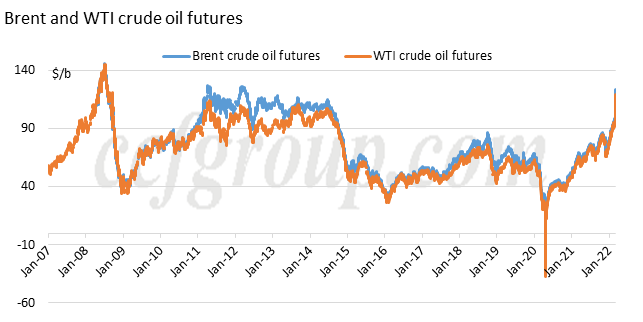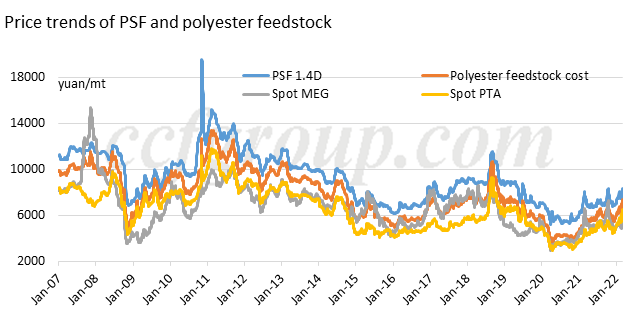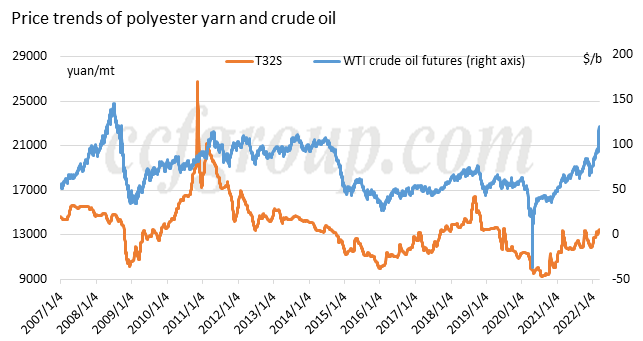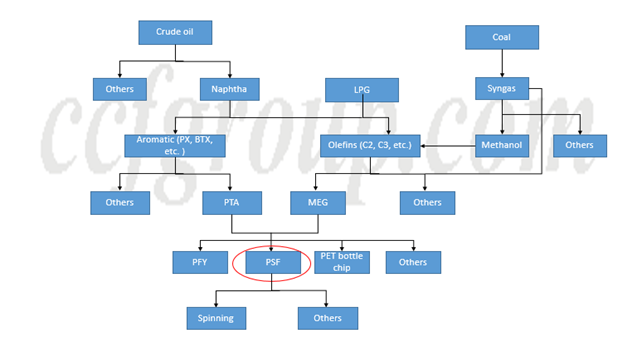Name:HENAN GUANGDA TEXTILES IMP. & EXP. CO., LTD.
Add:10/F,XinMangGuo Building,No.9 Business Outer Ring Road,ZhengDong New District,ZhengZhou,China
Tel:86-371-60170260
Fax:0371-60136222
Postcode:450000
Web:www.hngdtex.com
Russia is the second largest exporter of crude oil over the world, and the export volume takes up 25% in global export trades. Crude oil price has been intensely volatile since the outbreak of Russia-Ukraine war. As the sanctions on Russia by Europe and the US intensified, the concerns on supply suspension of Russian energy escalated. In the past six trading days, Brent crude oil futures once increased by $41/b, pushing crude oil price to the highest since Jul 2008.



However, polyester feedstock, PSF and polyester yarn are still at a medium level since 2007. Why don’t they rush up?
1. Crude oil price depends on supply and demand situation, and decides the costs of downstream products.
The surge of crude oil mainly roots in the panic caused by expected excessive demand upon the supply suspension of Russian crude oil. Even the resumption of Iran’s crude oil export and the lift of the ban on Venezuela’s oil export could not make up the supply gap. Thus, the supply and demand situation determines the price of crude oil.

The chart above shows the process of PSF production. Polyester feedstock cost= PTA*0.855 + MEG*0.335. Crude oil price influences the cost of PSF to a great extent. Therefore, along with the rise of crude oil, polyester industrial chain moves up, including polyester yarn.
2. Bearish demand drags the rise of PSF price and expanding losses affect supply and demand pattern.
Currently, PX, PTA and MEG all suffer great losses, and PTA-PX spread even turned negative on Mar 8 for the first time in the record. Polyester products like PSF, POY, FDY and PET fiber chip are all hit. It is resulted from sluggish downstream demand essentially. After Spring Festival holiday, textile and apparel industry saw soft demand. Firstly, amid high inflation, the demand from outside China declined. Secondly, the mills in Southeast Asia resumed production, and some orders flowed there. In addition, the slump of polyester feedstock diminished the speculative demand before Russia-Ukraine conflict. As a result, downstream orders were not prosperous after Spring Festival holiday, and thereby, polyester feedstock and PSF prices were dragged down to relatively low level amid strong crude oil.
Under losses, the plants successively released maintenance plans, including PX, PTA, MEG, PSF and PFY. The operating rate of PSF is expected to drop to about 80% by late Mar from current 86%. Polyester yarn mills have not planned to suspend production with low inventory and sound profit. Now the supply and demand pattern along the whole industrial chain is changed.
Russia-Ukraine conflict has lasted tens of days and bites all around. If crude oil maintains volatile at over $110/b, polyester industrial chain will be challenged and polyester yarn will be more influenced in Apr at the latest.